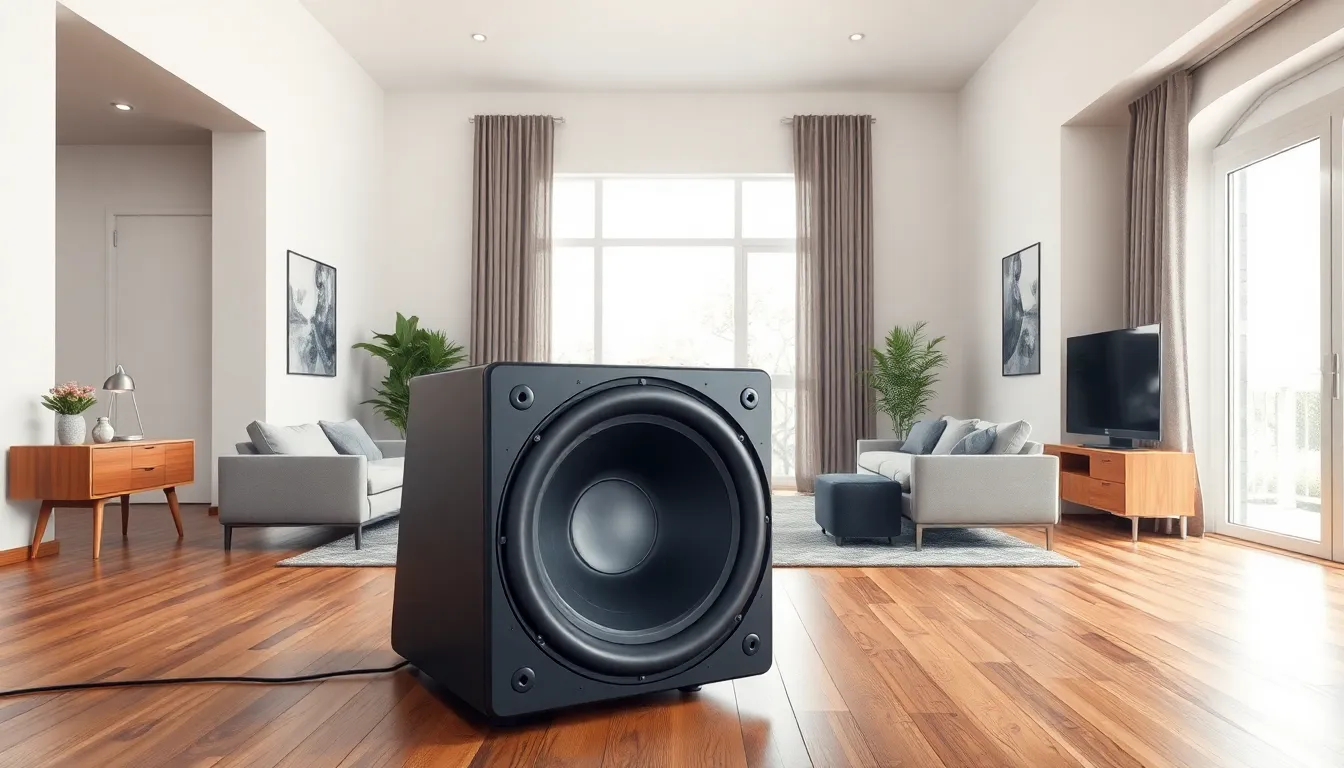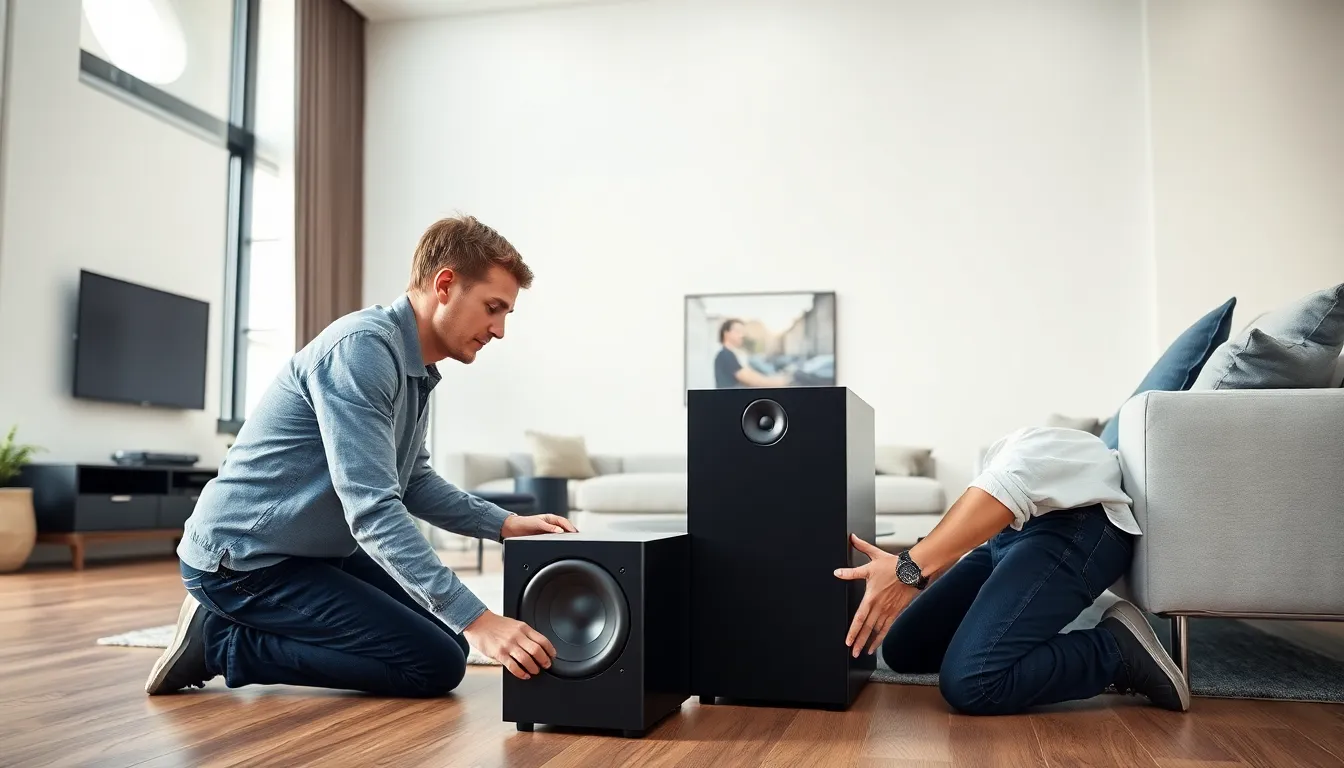Finding the perfect spot for a subwoofer can feel like a game of musical chairs—only instead of chairs, it’s your beloved bass machine, and the stakes are higher than just a sore backside. Place it right, and you’ll feel the earth shake beneath your feet; place it wrong, and you might as well be listening to a kazoo.
Subwoofer placement isn’t just about aesthetics; it’s about transforming your listening experience from “meh” to “wow.” Whether you’re jamming to your favorite tunes or diving into the latest blockbuster, the right position can make all the difference. So, let’s dive into the science of bass and explore how to unleash the true power of your subwoofer without turning your living room into a soundproof bunker.
Table of Contents
ToggleImportance Of Subwoofer Placement
Subwoofer placement plays a crucial role in optimizing audio performance. Achieving balanced bass requires careful consideration of location within the room. Strategic positioning enhances sound quality, ensuring an immersive listening experience.
Bass frequencies behave differently than higher frequencies, necessitating unique placement strategies. Understanding room acoustics and the interaction of sound waves can lead to significant improvements. For instance, placing a subwoofer in a corner often amplifies bass but may create uneven sound distribution.
Avoiding specific areas, such as near walls or in corners, can help mitigate undesirable resonances. Instead, exploring spots like one-third of the way into the room often yields better results. Testing multiple positions helps determine which location produces the most satisfying bass response.
Some experts recommend the use of the “subwoofer crawl” method. This involves placing the subwoofer at the primary listening position and moving around the room to identify where the bass sounds best. This approach ensures the chosen spot offers the best audio performance.
Subwoofer placement also affects aesthetic considerations within a living space. Integrating the subwoofer seamlessly into the room’s design enhances both functionality and visual appeal. Therefore, combining acoustic principles with design strategies creates an optimal listening environment without compromising style.
Ultimately, proper subwoofer placement not only enhances sound quality but also ensures an enjoyable audio experience, underscoring its significance in any home theater or music setup.
Factors To Consider

Subwoofer placement involves several critical factors that can influence audio performance. Evaluating each factor ensures the optimal listening experience.
Room Characteristics
Room dimensions, shape, and construction materials impact sound quality. A larger room may require a more powerful subwoofer to fill the space with bass. Acoustic properties, such as reflections from walls, also affect bass frequencies. Carpeted floors absorb sound differently than hardwood or tile surfaces. While avoiding corners can reduce unwanted bass resonances, experimenting with various locations helps identify the best sound.
Subwoofer Type
Each subwoofer type possesses distinct characteristics affecting placement. Front-firing subwoofers project sound directly, making them effective in open areas. Down-firing models offer benefits in tight spaces since they utilize the floor to amplify sound. Ported subwoofers deliver deeper bass but require more room away from walls. Understanding the unique attributes of each model guides strategic placement for optimal performance.
Listening Position
Identifying the primary listening position serves as a cornerstone for subwoofer placement. It often acts as the focal point for sound within a room. Placing the subwoofer near this position promotes balanced sound across frequencies. Considering listener preferences adds another layer to placement decisions. Adjusting placement slightly can produce noticeable differences in bass response and clarity, enhancing the overall auditory experience.
Placement Techniques
Finding the optimal position for a subwoofer can significantly enhance audio performance. Several techniques exist to ensure the best sound experience.
Corner Placement
Corner placement often leads to an increase in bass response but can cause uncontrolled resonances. Subwoofers placed in corners might produce louder bass, yet this effect can create a muddy sound. To avoid potential issues, it’s best to analyze the specific acoustics of the room. Testing different corner locations may yield desirable results, but monitoring sound quality ensures balance isn’t sacrificed.
Wall Placement
Wall placement allows for flexibility and can provide good bass responsiveness in smaller spaces. Positioning the subwoofer along a wall often mitigates resonance problems experienced in corners. Care should be taken to avoid positioning too close to the wall, which can amplify unwanted vibrations. Checking the distance from the wall and experimenting with various heights helps achieve the best sound clarity.
Free-Field Placement
Free-field placement involves placing the subwoofer away from walls and corners for optimal performance. Keeping it in an open area not only minimizes reflections but also enhances the depth of bass frequencies. This position requires enough space to avoid obstacles that might interfere with sound propagation. Adjusting the distance from the primary listening area allows for fine-tuning the overall bass experience.
Common Mistakes
Mistakes in subwoofer placement can hinder audio performance. Understanding common errors helps improve overall sound quality.
Ignoring Room Acoustics
Room acoustics play a crucial role in sound quality. Neglecting these factors leads to issues like standing waves and dead spots. Sound waves behave differently depending on the room’s shape and materials. Heavier drapes or carpets absorb sound, while bare walls reflect it, affecting overall bass response. Placing a subwoofer without considering room acoustics often results in uneven bass. Evaluating the room’s dimensions, furniture arrangement, and surfaces before placement ensures a more balanced sound experience.
Incorrect Calibration
Calibration mistakes also impact subwoofer performance. Using default settings doesn’t optimize sound for individual spaces. Each subwoofer and room combination requires tailored calibration to ensure balanced output. Overlooking phase adjustments can lead to muddy sound. Incorrect crossover settings disrupt the seamless integration of bass with other speakers. Utilizing calibration tools or apps provides accurate measurements for optimal tuning. Spending time on proper calibration significantly enhances audio reproduction, making it essential for an enjoyable listening experience.
Finding the optimal subwoofer placement is key to unlocking a superior audio experience. It’s not just about where the subwoofer sits; it’s about how that position interacts with the room’s acoustics. By avoiding common pitfalls and utilizing techniques like the subwoofer crawl, listeners can discover the sweet spot that delivers balanced bass.
Moreover, understanding the unique characteristics of the room and the subwoofer type can further enhance sound quality. Proper calibration is also essential to ensure the system performs at its best. With careful attention to these factors, anyone can transform their audio setup into a rich and immersive experience that elevates music and movie enjoyment to new heights.

